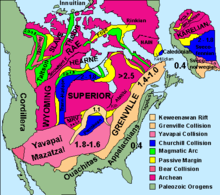
Back Laurentia Afrikaans لورنشيا Arabic Лаврентия Bulgarian Laurentia BS Laurèntia Catalan Laurentie Czech Лаврентия CV Laurentia (Kontinent) German Laurentia (continente) Spanish Laurentia Estonian

Laurentia or the North American Craton is a large continental craton that forms the ancient geological core of North America. Many times in its past, Laurentia has been a separate continent, as it is now in the form of North America, although originally it also included the cratonic areas of Greenland and the Hebridean Terrane in northwest Scotland. During other times in its past, Laurentia has been part of larger continents and supercontinents and consists of many smaller terranes assembled on a network of early Proterozoic orogenic belts. Small microcontinents and oceanic islands collided with and sutured onto the ever-growing Laurentia, and together formed the stable Precambrian craton seen today.[1][2][3]
- ^ Hoffman, Paul F. (1988). "United Plates of America, The Birth of a Craton: Early Proterozoic Assembly and Growth of Laurentia". Annual Review of Earth and Planetary Sciences. 16: 543–603. Bibcode:1988AREPS..16..543H. doi:10.1146/annurev.ea.16.050188.002551. Archived from the original on 7 September 2020. Retrieved 25 April 2020.
- ^ Dalziel, I.W.D. (1992). "On the organization of American Plates in the Neoproterozoic and the breakout of Laurentia" (PDF). GSA Today. Vol. 2, no. 11. pp. 237–241. Archived (PDF) from the original on 17 October 2016. Retrieved 25 April 2020.
- ^ Whitmeyer, Steven; Karlstrom, Karl E. (2007). "Tectonic model for the Proterozoic growth of North America". Geosphere. 3 (4): 220. doi:10.1130/GES00055.1.